-
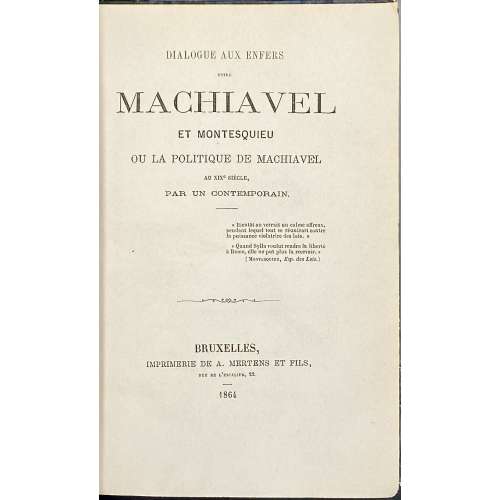 Title page: DIALOGUE AUX ENFERS | ENTRE | MACHIAVEL | ET MONTESQUIEU | OU LA POLITIQUE DE MACHIAVEL | AU XIXe SIÈCLE, | PAR UN CONTEMPORAIN. | {6 lines of citations} | ~ | BRUXELLES, | IMPRIMERIE DE A. MERTENS ET FILS, | RUE DE L’ESCALIER, 22. | – | 1864 || Description: 19 x 12.7 cm, quarter green morocco over blue marbled boards, spine with raised bands ruled in gilt, gilt fleurons in compartments, gilt lettering, marbled endpapers; three paper clippings laid in. Collation: 12mo; π5 1-2712 292; total 175 leaves. Pagination: [2] blank, [2] h.t, [2] t.p. [i] ii-iii [iv] [1] 2-337 [338] blank [2] errata]; total 350 pages. Contributors: Maurice Joly (French, 1829 – 1878) – author. Characters: Niccolò Machiavelli (Italian, 1469 – 1527) Charles Louis de Secondat, baron de La Brède et de Montesquieu (French, 1689 – 1755) The publication was funded by the author and smuggled into France. See other copies: LIB-2913.2021, LIB-1034.2016 and LIB-0460.2015. Other related objects: SVVP-0062.2021. Seller's description: [JOLY (Maurice)]: Dialogue aux enfers entre Machiavel et Montesquieu. Bruxelles, Mertens et fils, 1864 ; un volume in 12, demi-chagrin vert orné de l'époque. C'est dans ce livre que Joly écrit, au prétexte d'une discussion philosophique et politique, comment Napoléon III, selon lui, a manipulé les milieux économiques, la presse, l'opinion publique, les syndicats, les milieux ouvriers, le peuple, etc., pour établir un pouvoir politique fort, ce qui lui valut un séjour de 15 mois à la prison Sainte-Pélagie à Paris.
Title page: DIALOGUE AUX ENFERS | ENTRE | MACHIAVEL | ET MONTESQUIEU | OU LA POLITIQUE DE MACHIAVEL | AU XIXe SIÈCLE, | PAR UN CONTEMPORAIN. | {6 lines of citations} | ~ | BRUXELLES, | IMPRIMERIE DE A. MERTENS ET FILS, | RUE DE L’ESCALIER, 22. | – | 1864 || Description: 19 x 12.7 cm, quarter green morocco over blue marbled boards, spine with raised bands ruled in gilt, gilt fleurons in compartments, gilt lettering, marbled endpapers; three paper clippings laid in. Collation: 12mo; π5 1-2712 292; total 175 leaves. Pagination: [2] blank, [2] h.t, [2] t.p. [i] ii-iii [iv] [1] 2-337 [338] blank [2] errata]; total 350 pages. Contributors: Maurice Joly (French, 1829 – 1878) – author. Characters: Niccolò Machiavelli (Italian, 1469 – 1527) Charles Louis de Secondat, baron de La Brède et de Montesquieu (French, 1689 – 1755) The publication was funded by the author and smuggled into France. See other copies: LIB-2913.2021, LIB-1034.2016 and LIB-0460.2015. Other related objects: SVVP-0062.2021. Seller's description: [JOLY (Maurice)]: Dialogue aux enfers entre Machiavel et Montesquieu. Bruxelles, Mertens et fils, 1864 ; un volume in 12, demi-chagrin vert orné de l'époque. C'est dans ce livre que Joly écrit, au prétexte d'une discussion philosophique et politique, comment Napoléon III, selon lui, a manipulé les milieux économiques, la presse, l'opinion publique, les syndicats, les milieux ouvriers, le peuple, etc., pour établir un pouvoir politique fort, ce qui lui valut un séjour de 15 mois à la prison Sainte-Pélagie à Paris. -
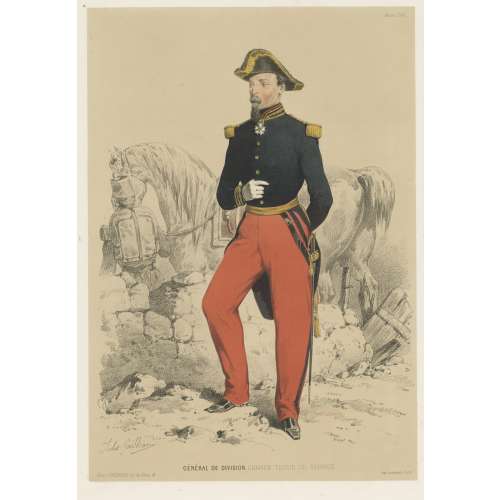 Chromolithography on thick wove paper, 473 x 315 mm sheet, 372 x 260 mm image, black ink stamp “5050” to reverse. Signed on stone "Jules Gaildrau"; below centre: "GÉNERAL DE DIVISION, GRANDE TENUE DE SERVICE"; Bottom left: "Paris, J. Gaildrau, rue de Seine, 16"; right: "Imp. Lemercier, Paris." Joseph Lemercier (French, 1803 – 1887) – printer. Jules Gaildrau (French, 1816 – 1898) – artist.
Chromolithography on thick wove paper, 473 x 315 mm sheet, 372 x 260 mm image, black ink stamp “5050” to reverse. Signed on stone "Jules Gaildrau"; below centre: "GÉNERAL DE DIVISION, GRANDE TENUE DE SERVICE"; Bottom left: "Paris, J. Gaildrau, rue de Seine, 16"; right: "Imp. Lemercier, Paris." Joseph Lemercier (French, 1803 – 1887) – printer. Jules Gaildrau (French, 1816 – 1898) – artist. -
 Artist: Utagawa Kunisada [歌川 国貞] a.k.a. Utagawa Toyokuni III [三代歌川豊国] (Japanese, 1786 – 1865). Signed: Ōju Toyokuni ga [応需豊国画], in a toshidama cartouche. Double nanushi censor seals: Mera & Murata (1846-50). Publisher: Kojimaya Jūbei [小嶋屋重兵衛] (Japanese, fl. c. 1797 – 1869). A beautiful woman, possibly a kabuki actor Iwai Hanshirō VIII [岩井半四郎] (Iwai Shijaku II, Iwai Kumesaburō III [岩井粂三郎], Iwai Hisajirō II, Japanese, 1829 – 1882), tuning the samisen on a veranda under the shining stars. The complete set of series Moon, Sun, Stars [月日星] (tsuki-hi-hoshi/boshi), three sources of light (sankō) [三光]:
Artist: Utagawa Kunisada [歌川 国貞] a.k.a. Utagawa Toyokuni III [三代歌川豊国] (Japanese, 1786 – 1865). Signed: Ōju Toyokuni ga [応需豊国画], in a toshidama cartouche. Double nanushi censor seals: Mera & Murata (1846-50). Publisher: Kojimaya Jūbei [小嶋屋重兵衛] (Japanese, fl. c. 1797 – 1869). A beautiful woman, possibly a kabuki actor Iwai Hanshirō VIII [岩井半四郎] (Iwai Shijaku II, Iwai Kumesaburō III [岩井粂三郎], Iwai Hisajirō II, Japanese, 1829 – 1882), tuning the samisen on a veranda under the shining stars. The complete set of series Moon, Sun, Stars [月日星] (tsuki-hi-hoshi/boshi), three sources of light (sankō) [三光]: -
 Katsukawa Shun'ei. The Sumo Bout between Yotsuguruma (right) and Yamaoroshi (left). Date: 1800 or 1805/06. Similar sheet can be found at Edo Tokyo Museum. Size: Vertical Ōban. Sumo wrestler Yotsuguruma Daihachi (1772 - 1809) first appeared in the records of national tournaments in winter of 1794. Then he lost 3 matches and won zero. He first won in the spring tournament of 1797 in a match against maegashira (the fifth-highest rank of sumo wrestlers) named Kougamine. Yamaoroshi Gengo (born 1762) came in at the winter tournament of 1799 . He was much more successful in his career than Yotsuguruma, but he had never won a tournament. It was the time of great Raiden, who won most of them. In the spring tournament of 1800 Yotsuguruma and Yamaoroshi fought against each other for the first time. Yotsuguruma lost. The next time they met on the ring was at the winter tournament of 1805, and again in 1806. Both matches were won by Yamaoroshi. Yamaoroshi retired in 1809; Yotsuguruma died in 1809.
Katsukawa Shun'ei. The Sumo Bout between Yotsuguruma (right) and Yamaoroshi (left). Date: 1800 or 1805/06. Similar sheet can be found at Edo Tokyo Museum. Size: Vertical Ōban. Sumo wrestler Yotsuguruma Daihachi (1772 - 1809) first appeared in the records of national tournaments in winter of 1794. Then he lost 3 matches and won zero. He first won in the spring tournament of 1797 in a match against maegashira (the fifth-highest rank of sumo wrestlers) named Kougamine. Yamaoroshi Gengo (born 1762) came in at the winter tournament of 1799 . He was much more successful in his career than Yotsuguruma, but he had never won a tournament. It was the time of great Raiden, who won most of them. In the spring tournament of 1800 Yotsuguruma and Yamaoroshi fought against each other for the first time. Yotsuguruma lost. The next time they met on the ring was at the winter tournament of 1805, and again in 1806. Both matches were won by Yamaoroshi. Yamaoroshi retired in 1809; Yotsuguruma died in 1809. -
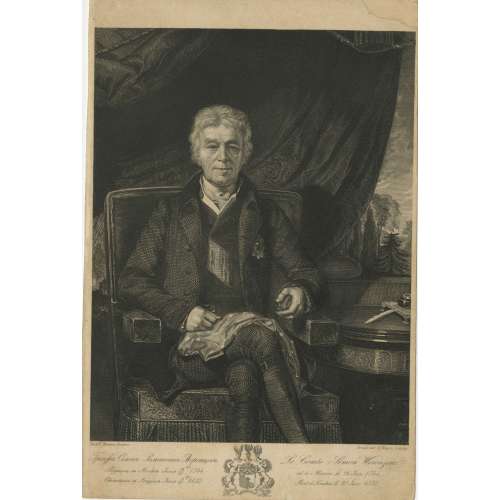
Seated portrait of Russian diplomat Count Semyon Romanovich Vorontsov (Семён Романович Воронцо́в; 26 June 1744 – 9 July 1832). Engraved by August Weger (Born: 1823 in Nürnberg; died: 1892 in Leipzig) from the portrait painted by Richard Evans (1784–1871). Circa 1825-50. Semyon Romanovich Vorontsov, the son of Count Roman Illarionovich and Marfa Ivanovna Surmina, was born on June 15, 1744; Active Privy Councillor; Ambassador to Venice and London from 1784, for over 20 years. Died in London on June 26, 1832.
Inscription: Графъ Семенъ Романовичь Воронцовъ. Родился въ Москвѣ Iюня 15-го/26 1744, Скончался въ Лондонѣ Iюня 9-го/21 1822. | Le Comte Simon Woronzow. né à Moscou le 26 Juin 1744, Mort à Londres le 21 Juin 1832. | Richd. Evans, Peintre. - Gravé par A. Weger, Leipzig. Vorontsov family coat of arms in the middle.
Dimensions: 23 x 15 cm. Ref.: Подробный словарь русских гравированных портретов Д. А. Ровинского, том. 1, 534-540. -
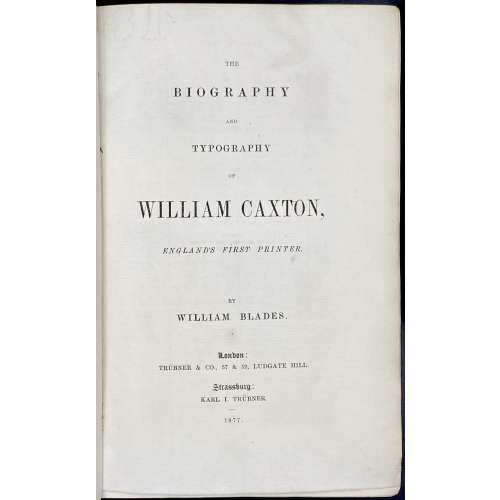 Title: THE | BIOGRAPHY AND | TYPOGRAPHY | OF | WILLIAM CAXTON, | ENGLAND'S FIRST PRINTER. | BY | WILLIAM BLADES. | LONDON : | TRÜBNER & CO, 57 & 59 LUDGATE HILL. | STRASSBURG : | KARL I. TRÜBNER. | 1877. || Pagination: ffl, [2] blank, [i, ii] - t.p., imprint, [iii], iv, v - preface, [vi] - cul-de-lampe, [vii], viii - contents; [1], 2-383 [384] - imprint, 2] - blanks, bfl.; 18 plates: op. p. 8, 22, 54 (3), 60, 126 (4), 283, [311], 336, 358 (5). Collation: 8vo; [A]4 B-Z8 AA8 BB7. Exterior: 22.6 x 14.8 cm, printed on watermarked Zanders laid paper, original brown decorated paper boards, spine with decoration and lettering, marbled end-papers, water stain to bottom of upper cover, slightly rubbed, upper margin marbled, other untrimmed, binder's mark to back pastedown: "Bound by Simpson & Renshaw". Bookplates to front pastedown: upper: F. Marcham | Tempora mutantur, nos et mutamur in illis. | Hornsey | 1907"; lower: (2) "From the library of | H. Harvey Frost". Caxton, William (British, c. 1422 – 1491). Blades, William (British, 1824-1890) Frank Marcham (1883 – 1934), motto: "Times are changed, we also are changed with them". This book is based on the author's The Life and Typography of William Caxton, London: J. Lilly, 1861-63, – "A new 'Life' in a more handy form".
Title: THE | BIOGRAPHY AND | TYPOGRAPHY | OF | WILLIAM CAXTON, | ENGLAND'S FIRST PRINTER. | BY | WILLIAM BLADES. | LONDON : | TRÜBNER & CO, 57 & 59 LUDGATE HILL. | STRASSBURG : | KARL I. TRÜBNER. | 1877. || Pagination: ffl, [2] blank, [i, ii] - t.p., imprint, [iii], iv, v - preface, [vi] - cul-de-lampe, [vii], viii - contents; [1], 2-383 [384] - imprint, 2] - blanks, bfl.; 18 plates: op. p. 8, 22, 54 (3), 60, 126 (4), 283, [311], 336, 358 (5). Collation: 8vo; [A]4 B-Z8 AA8 BB7. Exterior: 22.6 x 14.8 cm, printed on watermarked Zanders laid paper, original brown decorated paper boards, spine with decoration and lettering, marbled end-papers, water stain to bottom of upper cover, slightly rubbed, upper margin marbled, other untrimmed, binder's mark to back pastedown: "Bound by Simpson & Renshaw". Bookplates to front pastedown: upper: F. Marcham | Tempora mutantur, nos et mutamur in illis. | Hornsey | 1907"; lower: (2) "From the library of | H. Harvey Frost". Caxton, William (British, c. 1422 – 1491). Blades, William (British, 1824-1890) Frank Marcham (1883 – 1934), motto: "Times are changed, we also are changed with them". This book is based on the author's The Life and Typography of William Caxton, London: J. Lilly, 1861-63, – "A new 'Life' in a more handy form". -
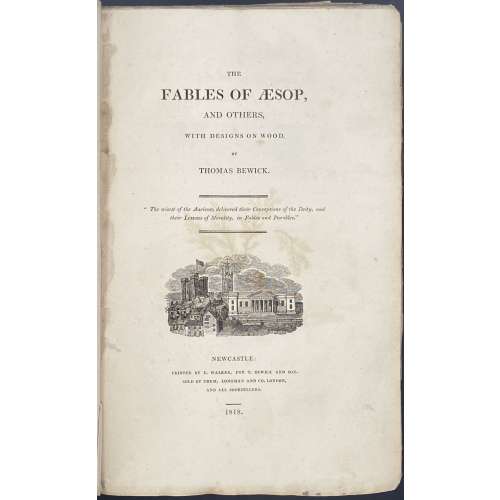 Title: THE | FABLES OF ÆSOP, | AND OTHERS, | WITH DESIGNS ON WOOD, | BY | THOMAS BEWICK. | “The wisest of the Ancients delivered their Conceptions of the Deity, and their Lessons of Morality, in Fables and Parables.” | {vignette} | NEWCASTLE: | PRINTED BY E. WALKER, FOR T. BEWICK AND SON. | SOLD BY THEM, LONGMAN AND CO. LONDON, AND ALL BOOKSELLERS. | 1818. || Pagination: [2] – blank / receipt with thumbprint, [i, ii] – t.p. / blank, [iii] iv-xvi – introduction with “Auld Clouty” vignette, [xvii] xviii-xxiv – table of contents, [1] 2-376; 188 wood-engraved head-pieces to the fables and 136 other vignettes, tail-pieces, etc. Collation: demy 8vo( octavo in fours); π1 (receipt), a-c4, B-3B4; A and 2P2 unsigned. Binding: Original blue boards, rebacked, original spine laid down, with original paper spine label ("Demy Paper/Price 15 s."); wove paper, top edge trimmed, the others are not; round book-plate to front paste-down “TWM, The Whitehead Library”; in a clamshell case, also book-plated inside. Size: case: 24.2 x 16.2 cm; boards: 22.8 x 14.2 cm; 22 x 14 cm. Note from seller: First copy in boards to ever appear at auction. Edition: First edition (one of 1,000 copies printed in demy 8vo), with Bewick's thumbprint and signature in facsimile, “Demy” and “15” in manuscript on receipt (page facing title-page), variant A (with "Auld Clouty" wood-engraving at bottom of p. XVI, and with the last line in p. 248 reading "road of honour and honesty"). "According to Roscoe, demy 8vo copies were apparently the first to be issued". There is 1 copy at the University Library, Cambridge and 1 at Liverpool public libraries. Catalogue raisonné: Roscoe: pp. 155-165, 45c for Variant A [see LIB-2714.2021]; Hugo (I vol.): p. 261; Ray: p. 35; Steedman: №№ 99-104, pp. 34-35 (№ 103 for Variant A).
Title: THE | FABLES OF ÆSOP, | AND OTHERS, | WITH DESIGNS ON WOOD, | BY | THOMAS BEWICK. | “The wisest of the Ancients delivered their Conceptions of the Deity, and their Lessons of Morality, in Fables and Parables.” | {vignette} | NEWCASTLE: | PRINTED BY E. WALKER, FOR T. BEWICK AND SON. | SOLD BY THEM, LONGMAN AND CO. LONDON, AND ALL BOOKSELLERS. | 1818. || Pagination: [2] – blank / receipt with thumbprint, [i, ii] – t.p. / blank, [iii] iv-xvi – introduction with “Auld Clouty” vignette, [xvii] xviii-xxiv – table of contents, [1] 2-376; 188 wood-engraved head-pieces to the fables and 136 other vignettes, tail-pieces, etc. Collation: demy 8vo( octavo in fours); π1 (receipt), a-c4, B-3B4; A and 2P2 unsigned. Binding: Original blue boards, rebacked, original spine laid down, with original paper spine label ("Demy Paper/Price 15 s."); wove paper, top edge trimmed, the others are not; round book-plate to front paste-down “TWM, The Whitehead Library”; in a clamshell case, also book-plated inside. Size: case: 24.2 x 16.2 cm; boards: 22.8 x 14.2 cm; 22 x 14 cm. Note from seller: First copy in boards to ever appear at auction. Edition: First edition (one of 1,000 copies printed in demy 8vo), with Bewick's thumbprint and signature in facsimile, “Demy” and “15” in manuscript on receipt (page facing title-page), variant A (with "Auld Clouty" wood-engraving at bottom of p. XVI, and with the last line in p. 248 reading "road of honour and honesty"). "According to Roscoe, demy 8vo copies were apparently the first to be issued". There is 1 copy at the University Library, Cambridge and 1 at Liverpool public libraries. Catalogue raisonné: Roscoe: pp. 155-165, 45c for Variant A [see LIB-2714.2021]; Hugo (I vol.): p. 261; Ray: p. 35; Steedman: №№ 99-104, pp. 34-35 (№ 103 for Variant A). -
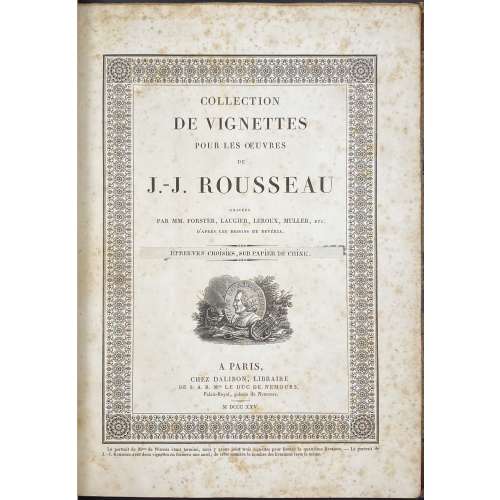 Pictorial album of 41 etchings, incl. two portraits, by various engravers after Achille Devéria, printed on India paper (after letters) and pasted on thick wove paper, bound with tissue guards in half calf over marbled boards bordered gilt, spine decorated gilt, marbled endpapers; base paper and tissue guards are substantially foxed, images mostly intact. The title page and the subscription page are bound-in at the beginning and at the end, respectively. Title page: (in ornamental frame): COLLECTION | DE VIGNETTES | POUR LES ŒUVRES | DE | J.-J. ROUSSEAU | GRAVÉES | PAR MM. FORSTER, LAUGIER, LEROUX, MULLER, ETC. | D'APRÈS LES DESSINS DE DEVÉRIA. | (pasted over) ÉPREUVES CHOISIES, SUR PAPIER DE CHINE. | {publisher’s device} | A PARIS, | CHEZ DALIBON, LIBRAIRE | DE S. A. R. MGR LE DUC DE NEMOURS, | Palais-Royal, galerie de Nemours. | M DCCC XXV. | Under the frame: Le portrait de Mme de Warens étant terminé, nous y avons joint trois vignettes pour former la quatrième livraison. — Le portrait de | J.-J. Rousseau avec deux vignettes en formera une aussi ; de cette manière le nombre des livraisons reste le même. || This collection was published by Dalibon the same year as the 25-volume Rousseau's Œuvres completes. Related persons: Jean-Jacques Rousseau (French, 1712 – 1778). Mme de Warens: Françoise-Louise de Warens [Louise Éléonore de la Tour du Pil] Swiss, 1699 – 1762). S.A.R. Mgr Le Duc de Nemours: Prince Louis of Orléans, Duke of Nemours [Louis Charles Philippe Raphaël d'Orléans] (French, 1814 – 1896). Contributors: François-Denis Dalibon (French, 1794 – 1853) – publisher. L'Imprimerie de Rignoux (Paris); Thomas-François Rignoux (1781 – 1863?) – printer. Achille Devéria (French, 1800 – 1857) – artist. Engravers : François Forster (French, 1790 – 1872) Jean Nicolas Laugier (French, 1785 – 1875) Jean Marie Leroux (French, 1788 – 1871) Henri Charles Müller (French, 1784 – 1845) Herbert König (German, 1820 – 1876) Louis Jean Désiré Delaistre (French, 1800 – 1871) Jean Louis Toussaint Caron (French, 1790 – 1832) Pierre Michel Adam (French, 1799 – 1853) Ferdinand Sébastien Goulu (French, 1796 – 1848) Jean-François Pourvoyeur (French, 1784 – 1851) Jean Baptiste Touzé (French, fl. 1810 – 1830) Narcisse Lecomte (French, 1794 – 1882) Louis Hercule Sisco (French, 1778 – 1861) Edme Jean Ruhierre (French, 1789 – fl. 1826) Auguste Thomas Marie Blanchard (French, 1819 – 1898) François Manceau (French, 1768 – after 1837) Gabriel Louis Lacour-Lestudier (French, 1800 – 1849) Fulley [Frilley?] Jean Jacques Frilley (French, 1797 – after 1850) Philippe Joseph Augustin Vallot (French, 1796 – 1870) Etienne Devilliers (French, 1784 – after 1844) Jean Bosq (French, fl. c. 1801 – 1844) Zachée Prévost (French, 1797 – 1861) Jean Baptiste Guyard II (French, 1787 – 1831/32) Antoine François Gelée (French, 1796-1860) Constant Louis Antoine Lorichon (French, 1800-1856?) Antoine Joseph Chollet (French, 1793 – after 1848) Adrien Migneret (French, 1786 – 1840) Alfred Johannot (French, 1800 – 1837) Arnold Jéhotte (French, 1789 – 1836) Hippolyte Prudhomme (French, 1793 – 1853) Achille Lefèvre (French, 1798 – 1864) Pierre Pelée (French, 1801 – 1871) Antoine [Tony] Johannot (French, 1803 – 1852) Pierre Joseph Tavernier (French, 1787 – after 1845) Leclerc (?) Levasseur (?)
Pictorial album of 41 etchings, incl. two portraits, by various engravers after Achille Devéria, printed on India paper (after letters) and pasted on thick wove paper, bound with tissue guards in half calf over marbled boards bordered gilt, spine decorated gilt, marbled endpapers; base paper and tissue guards are substantially foxed, images mostly intact. The title page and the subscription page are bound-in at the beginning and at the end, respectively. Title page: (in ornamental frame): COLLECTION | DE VIGNETTES | POUR LES ŒUVRES | DE | J.-J. ROUSSEAU | GRAVÉES | PAR MM. FORSTER, LAUGIER, LEROUX, MULLER, ETC. | D'APRÈS LES DESSINS DE DEVÉRIA. | (pasted over) ÉPREUVES CHOISIES, SUR PAPIER DE CHINE. | {publisher’s device} | A PARIS, | CHEZ DALIBON, LIBRAIRE | DE S. A. R. MGR LE DUC DE NEMOURS, | Palais-Royal, galerie de Nemours. | M DCCC XXV. | Under the frame: Le portrait de Mme de Warens étant terminé, nous y avons joint trois vignettes pour former la quatrième livraison. — Le portrait de | J.-J. Rousseau avec deux vignettes en formera une aussi ; de cette manière le nombre des livraisons reste le même. || This collection was published by Dalibon the same year as the 25-volume Rousseau's Œuvres completes. Related persons: Jean-Jacques Rousseau (French, 1712 – 1778). Mme de Warens: Françoise-Louise de Warens [Louise Éléonore de la Tour du Pil] Swiss, 1699 – 1762). S.A.R. Mgr Le Duc de Nemours: Prince Louis of Orléans, Duke of Nemours [Louis Charles Philippe Raphaël d'Orléans] (French, 1814 – 1896). Contributors: François-Denis Dalibon (French, 1794 – 1853) – publisher. L'Imprimerie de Rignoux (Paris); Thomas-François Rignoux (1781 – 1863?) – printer. Achille Devéria (French, 1800 – 1857) – artist. Engravers : François Forster (French, 1790 – 1872) Jean Nicolas Laugier (French, 1785 – 1875) Jean Marie Leroux (French, 1788 – 1871) Henri Charles Müller (French, 1784 – 1845) Herbert König (German, 1820 – 1876) Louis Jean Désiré Delaistre (French, 1800 – 1871) Jean Louis Toussaint Caron (French, 1790 – 1832) Pierre Michel Adam (French, 1799 – 1853) Ferdinand Sébastien Goulu (French, 1796 – 1848) Jean-François Pourvoyeur (French, 1784 – 1851) Jean Baptiste Touzé (French, fl. 1810 – 1830) Narcisse Lecomte (French, 1794 – 1882) Louis Hercule Sisco (French, 1778 – 1861) Edme Jean Ruhierre (French, 1789 – fl. 1826) Auguste Thomas Marie Blanchard (French, 1819 – 1898) François Manceau (French, 1768 – after 1837) Gabriel Louis Lacour-Lestudier (French, 1800 – 1849) Fulley [Frilley?] Jean Jacques Frilley (French, 1797 – after 1850) Philippe Joseph Augustin Vallot (French, 1796 – 1870) Etienne Devilliers (French, 1784 – after 1844) Jean Bosq (French, fl. c. 1801 – 1844) Zachée Prévost (French, 1797 – 1861) Jean Baptiste Guyard II (French, 1787 – 1831/32) Antoine François Gelée (French, 1796-1860) Constant Louis Antoine Lorichon (French, 1800-1856?) Antoine Joseph Chollet (French, 1793 – after 1848) Adrien Migneret (French, 1786 – 1840) Alfred Johannot (French, 1800 – 1837) Arnold Jéhotte (French, 1789 – 1836) Hippolyte Prudhomme (French, 1793 – 1853) Achille Lefèvre (French, 1798 – 1864) Pierre Pelée (French, 1801 – 1871) Antoine [Tony] Johannot (French, 1803 – 1852) Pierre Joseph Tavernier (French, 1787 – after 1845) Leclerc (?) Levasseur (?) -
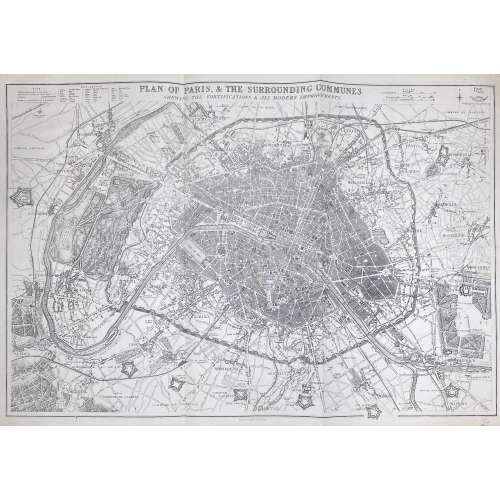 PLAN OF PARIS & THE SURROUNDING COMMUNES | SHEWING THE FORTIFICATIONS & ALL MODERN IMPROVEMENTS. || Lettered above the image with title, and below with production detail: "Day & Son, Lithrs to the Queen"; and production detail above: "Drawn & Engraved by B.R. Davies: / 16 George Str Euston Squ London", and on top right: "Weekly Dispatch Atlas, 138 Fleet Str". Dimensions: 47.5 x 65.4 cm. Contributors: Day & Son; William Day (British, 1797 – 1845) – lithographer, printer. Davies, Benjamin Rees (British, 1789 – 1872) – artist, engraver.
PLAN OF PARIS & THE SURROUNDING COMMUNES | SHEWING THE FORTIFICATIONS & ALL MODERN IMPROVEMENTS. || Lettered above the image with title, and below with production detail: "Day & Son, Lithrs to the Queen"; and production detail above: "Drawn & Engraved by B.R. Davies: / 16 George Str Euston Squ London", and on top right: "Weekly Dispatch Atlas, 138 Fleet Str". Dimensions: 47.5 x 65.4 cm. Contributors: Day & Son; William Day (British, 1797 – 1845) – lithographer, printer. Davies, Benjamin Rees (British, 1789 – 1872) – artist, engraver. -
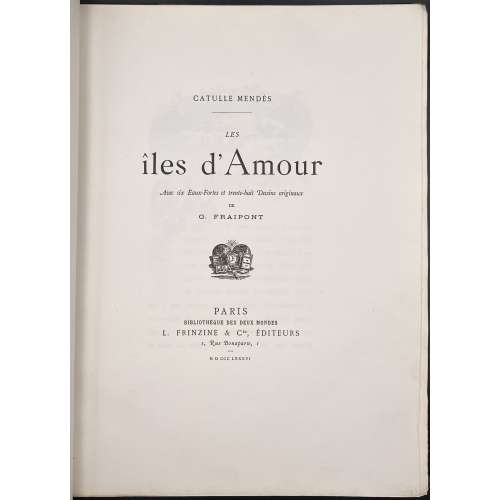 Description: Large volume collated in 4to, 33 x 25 cm, ¾ navy morocco bordered with a gilt double-fillet over marbled boards, raised bands, floral gilt arabesque in compartments, gilt lettering to spine, gilt endpapers, T.E.G. Text printed on wave paper watermarked “Whatman Turkey Mill 1884”; etchings printed on laid paper 32.2 x 24.3 cm, 20 x 13 platemark, 17 x 11 cm image; etched head- and tailpieces, initials. Printed on November 1, 1885. Title-page: CATULLE MENDÈS | — | LES | îles d'Amour | Avec six Eaux-Fortes et trente-huit Dessins originaux | DE | G. FRAIPONT | {publisher’s device} | PARIS | BIBLIOTHÈQUE DES DEUX MONDES | L. FRINZINE & Cie, ÉDITEURS | 1, Rue Bonaparte, 1 | – | M D CCC LXXXVI || Collation: 4to; π4, 1-114 122, total 50 leaves, two binder’s flyleaves in the front and in the back, and 6 plates extraneous to collation. Pagination: [i-v] vi-vii [viii] [1-3] 4-85 [86] [6], total 100 pages, ils. Limitation (printed in red and balck): 1000 copies on vergé (№ 1-1,000), 25 copies on Whatman (№ I-XXV), 15 copies on Japon Impérial (marked A-O). This is copy № III, signed by the publisher. Contributors: Catulle Mendès (French, 1841 – 1909) – author. Gustave Fraipont (Belgian-French, 1849 – 1923) – artist. Charles Unsinger (French, 1823 – 1891) – printer.
Description: Large volume collated in 4to, 33 x 25 cm, ¾ navy morocco bordered with a gilt double-fillet over marbled boards, raised bands, floral gilt arabesque in compartments, gilt lettering to spine, gilt endpapers, T.E.G. Text printed on wave paper watermarked “Whatman Turkey Mill 1884”; etchings printed on laid paper 32.2 x 24.3 cm, 20 x 13 platemark, 17 x 11 cm image; etched head- and tailpieces, initials. Printed on November 1, 1885. Title-page: CATULLE MENDÈS | — | LES | îles d'Amour | Avec six Eaux-Fortes et trente-huit Dessins originaux | DE | G. FRAIPONT | {publisher’s device} | PARIS | BIBLIOTHÈQUE DES DEUX MONDES | L. FRINZINE & Cie, ÉDITEURS | 1, Rue Bonaparte, 1 | – | M D CCC LXXXVI || Collation: 4to; π4, 1-114 122, total 50 leaves, two binder’s flyleaves in the front and in the back, and 6 plates extraneous to collation. Pagination: [i-v] vi-vii [viii] [1-3] 4-85 [86] [6], total 100 pages, ils. Limitation (printed in red and balck): 1000 copies on vergé (№ 1-1,000), 25 copies on Whatman (№ I-XXV), 15 copies on Japon Impérial (marked A-O). This is copy № III, signed by the publisher. Contributors: Catulle Mendès (French, 1841 – 1909) – author. Gustave Fraipont (Belgian-French, 1849 – 1923) – artist. Charles Unsinger (French, 1823 – 1891) – printer. -
 Artist: Utagawa Kunimaru [歌川国丸] (Japanese, 1794 – 1829). Publisher: Ibaya Senzaburō [伊場屋 仙三郎] (fl. 1815 – 1869). Date-kiwame seal: Bunsei 10 (1827). Signed: Ichiensai Kunimaru ga [一円斎国丸画]. Play: Chūshingura [忠臣蔵] (The Treasury of Loyal Retainers), 11th act, Night Battle [十一段目夜討之図]. Act XI: The Attack on Kō no Moronao Mansion. Kō no Moronao [高 師直] (Japanese, d. 1351). Ref: Ako City Museum of History Inscription on the soba peddler box: Nihachi soba udon [二八そば うどん] – twice eight soba and udon (16 mon per serving).
Artist: Utagawa Kunimaru [歌川国丸] (Japanese, 1794 – 1829). Publisher: Ibaya Senzaburō [伊場屋 仙三郎] (fl. 1815 – 1869). Date-kiwame seal: Bunsei 10 (1827). Signed: Ichiensai Kunimaru ga [一円斎国丸画]. Play: Chūshingura [忠臣蔵] (The Treasury of Loyal Retainers), 11th act, Night Battle [十一段目夜討之図]. Act XI: The Attack on Kō no Moronao Mansion. Kō no Moronao [高 師直] (Japanese, d. 1351). Ref: Ako City Museum of History Inscription on the soba peddler box: Nihachi soba udon [二八そば うどん] – twice eight soba and udon (16 mon per serving). -
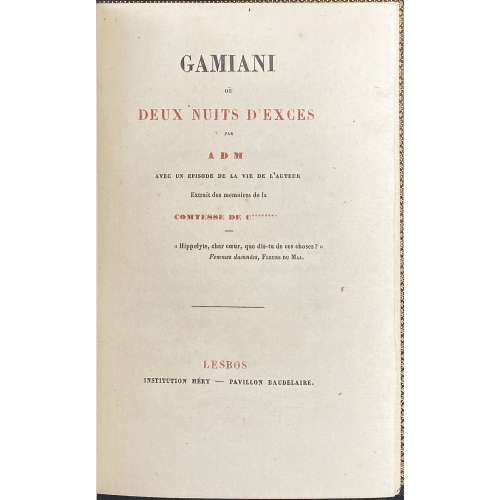 Single volume, 16.8 x 11.3 cm, bound in full dark olive crushed morocco by Brany (signed), gilt triple-fillet border to boards, spine with raised bands, gilt in compartments, gilt-lettered label, gilt dentelle inside, marbled endpapers, all margins gilt, gilt double fillet to boards margin; text printed on laid paper. Bookplate of Maurice Lebarbier de Tinan to fep 45 x 35 mm representing standing satyr with erected penis holding monogram ‘MT’ in his hands with a motto below on a ribbon ‘FAIRE SANS DIRE’. Maurice Lebarbier de Tinan book collection was dispersed via l’hôtel Drouot (Paris) on a sale from March 9 to 12, 1885; a catalogue was published: Catalogue d’un joli choix de livres anciens et modernes, en très belle condition de reliure, composant la bibliothèque de M. L. de T*** [Lebarbier de Tinan] (Paris, Ch. Porquet, 1885, in-8, VIII-140 p., 481 lots). Collation: π2 (h.t., t.p.) a6 b2 1-1112, total 82 leaves plus 18 engraved plates on wove paper; illustrations include engraved frontispiece and six etchings printed in two versions each, black and red, and one etching (at p. 103) in two states, two colour versions for each state, frontispiece and 3 or 4 plates after Félicien Rops, the others after original lithographs by Devéria and Henri Grévedon or Octave Tassaert for the 1833 edition (re-print of 1926 LIB-3135.2023). Pagination: [4] [i] ii-xvi, [3] 4-141 [3], total 164 pages, ils. Title-page (red and black): GAMIANI | OU | DEUX NUITS D’EXCES | PAR | A D M | AVEC UN EPISODE DE LA VIE DE L’AUTEUR | Extrait des mémoires de la | COMTESSE DE C******** | – | « Hippolyte, cher cœur, que dis-tu ces choses ? » | Femmes damnées, Fleurs du Mal. | — | LESBOS | INSTITUTION MERY — PAVILLON BAUDELAIRE. || Catalogue raisonné: Dutel I: A-464; Bory: 596-605; Pia: 516/7. According to Pia, the print run is limited to 150 copies on laid paper. Ref.: BNF Enfer 419. Fekete (Christie's): 135. Provenance: Maurice Lebarbier de Tinan (French, 1842 – 1918). Contributors: Alfred de Musset (French, 1810 – 1857) – author. Félicien Rops (Belgian, 1833 – 1898) – artist. Auguste Poulet-Malassis (French, 1825 – 1878) – publisher. Catalogue Poulet-Malassis & ses amis description: № 5. [Alfred de MUSSET] A D M. Gamiani ou Deux nuits d’excès, avec un épisode de la vie de l’auteur, extrait des mémoires de la comtesse de C********. Lesbos, Institution Méry, Pavillon Baudelaire [A. Poulet-Malassis, 1864]. Illustré de 8 gravures, dont l’une en frontispice, en double état (et quatre états pour la gravure « au singe » de la page 103) de Félicien Rops. Là où Baudelaire soutient Poulet-Malassis quand l’éditeur soutient l’attribution à Musset. Perfectionniste ? Trop cher ? Trop sollicité ? Pas toujours inspiré ? Rops réalisera rarement des suites complètes, ne répondant le plus souvent à la demande de ses commanditaires que par la conception de frontispices. Au verso du faux-titre, Launay voit une justification de 150 exemplaires sur papier vergé, paraphés et numérotés, qui ne figure pas ici. Très bel exemplaire relié par Brany. Provenance : Bibliothèque de Lebarbier de Tinan de Lebarbier de Tinan dont la collection fut dispersée en 1885, justifié par son ex-libris représentant un satyre en érection, portant la devise “Faire sans dire”. Bibliographie : Pia 558, Per 16-8, PC 1299, Lau 285, Enfer 419, Dutel A-464." [LIB-3118.2022]
Single volume, 16.8 x 11.3 cm, bound in full dark olive crushed morocco by Brany (signed), gilt triple-fillet border to boards, spine with raised bands, gilt in compartments, gilt-lettered label, gilt dentelle inside, marbled endpapers, all margins gilt, gilt double fillet to boards margin; text printed on laid paper. Bookplate of Maurice Lebarbier de Tinan to fep 45 x 35 mm representing standing satyr with erected penis holding monogram ‘MT’ in his hands with a motto below on a ribbon ‘FAIRE SANS DIRE’. Maurice Lebarbier de Tinan book collection was dispersed via l’hôtel Drouot (Paris) on a sale from March 9 to 12, 1885; a catalogue was published: Catalogue d’un joli choix de livres anciens et modernes, en très belle condition de reliure, composant la bibliothèque de M. L. de T*** [Lebarbier de Tinan] (Paris, Ch. Porquet, 1885, in-8, VIII-140 p., 481 lots). Collation: π2 (h.t., t.p.) a6 b2 1-1112, total 82 leaves plus 18 engraved plates on wove paper; illustrations include engraved frontispiece and six etchings printed in two versions each, black and red, and one etching (at p. 103) in two states, two colour versions for each state, frontispiece and 3 or 4 plates after Félicien Rops, the others after original lithographs by Devéria and Henri Grévedon or Octave Tassaert for the 1833 edition (re-print of 1926 LIB-3135.2023). Pagination: [4] [i] ii-xvi, [3] 4-141 [3], total 164 pages, ils. Title-page (red and black): GAMIANI | OU | DEUX NUITS D’EXCES | PAR | A D M | AVEC UN EPISODE DE LA VIE DE L’AUTEUR | Extrait des mémoires de la | COMTESSE DE C******** | – | « Hippolyte, cher cœur, que dis-tu ces choses ? » | Femmes damnées, Fleurs du Mal. | — | LESBOS | INSTITUTION MERY — PAVILLON BAUDELAIRE. || Catalogue raisonné: Dutel I: A-464; Bory: 596-605; Pia: 516/7. According to Pia, the print run is limited to 150 copies on laid paper. Ref.: BNF Enfer 419. Fekete (Christie's): 135. Provenance: Maurice Lebarbier de Tinan (French, 1842 – 1918). Contributors: Alfred de Musset (French, 1810 – 1857) – author. Félicien Rops (Belgian, 1833 – 1898) – artist. Auguste Poulet-Malassis (French, 1825 – 1878) – publisher. Catalogue Poulet-Malassis & ses amis description: № 5. [Alfred de MUSSET] A D M. Gamiani ou Deux nuits d’excès, avec un épisode de la vie de l’auteur, extrait des mémoires de la comtesse de C********. Lesbos, Institution Méry, Pavillon Baudelaire [A. Poulet-Malassis, 1864]. Illustré de 8 gravures, dont l’une en frontispice, en double état (et quatre états pour la gravure « au singe » de la page 103) de Félicien Rops. Là où Baudelaire soutient Poulet-Malassis quand l’éditeur soutient l’attribution à Musset. Perfectionniste ? Trop cher ? Trop sollicité ? Pas toujours inspiré ? Rops réalisera rarement des suites complètes, ne répondant le plus souvent à la demande de ses commanditaires que par la conception de frontispices. Au verso du faux-titre, Launay voit une justification de 150 exemplaires sur papier vergé, paraphés et numérotés, qui ne figure pas ici. Très bel exemplaire relié par Brany. Provenance : Bibliothèque de Lebarbier de Tinan de Lebarbier de Tinan dont la collection fut dispersée en 1885, justifié par son ex-libris représentant un satyre en érection, portant la devise “Faire sans dire”. Bibliographie : Pia 558, Per 16-8, PC 1299, Lau 285, Enfer 419, Dutel A-464." [LIB-3118.2022] -
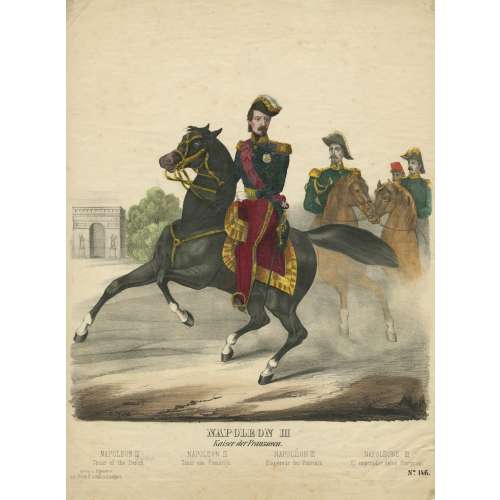 Hand-coloured lithography on wove paper 423 x 332 mm; On reverse: black ink stamp “4956”, ms “A”, ms pencil “428” and “Ernest”. Under the image, centre: "NAPOLEON III | Kaiser der Franzosen." Velow: | NAPOLEON III | Czaar of the French — NAPOLEON III | Czaar van Frankrijk — NAPOLÉON III | Empereur des Francais. — NAPOLEONE III | El emperador delos Franceses; bottom left: "Verlag u. Eigenthum | von. Fried. G. Schulz in Stuttgart.", right: "No 146." The artist's and printer's names in stone are not legible. Published in Stuttgart by Friederich Gustav Schulz (German, 1786 – 1859) during the time of the Second French Empire (1852-1870).
Hand-coloured lithography on wove paper 423 x 332 mm; On reverse: black ink stamp “4956”, ms “A”, ms pencil “428” and “Ernest”. Under the image, centre: "NAPOLEON III | Kaiser der Franzosen." Velow: | NAPOLEON III | Czaar of the French — NAPOLEON III | Czaar van Frankrijk — NAPOLÉON III | Empereur des Francais. — NAPOLEONE III | El emperador delos Franceses; bottom left: "Verlag u. Eigenthum | von. Fried. G. Schulz in Stuttgart.", right: "No 146." The artist's and printer's names in stone are not legible. Published in Stuttgart by Friederich Gustav Schulz (German, 1786 – 1859) during the time of the Second French Empire (1852-1870). -
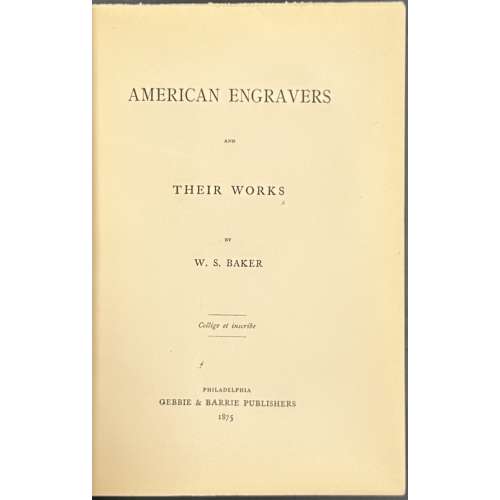 Hardcover, 19 x 13.8 cm, crimson buckram with tan paper label with lettering to spine; printed on laid paper; pp.: ffl [i-vi] vii-x] 11-184, collation 8vo, 1-118 124, total 92 leaves. Title-page: AMERICAN ENGRAVERS | AND | THEIR WORKS | BY | W. S. BAKER | Collige et inscribe | PHILADELPHIA | GEBBIE & BARRIE PUBLISHERS | 1875 || Motto: Collige et inscribe [Collect and record, lat.] Contributors: William Spohn Baker (American, 1824 – 1897) – author. George Gebbie (American, 1832 – 1892) – publisher. George Barrie (American, 1843 – 1918) – publisher. George R. Bonfield (British-American, 1802 – 1898) – dedicatee.
Hardcover, 19 x 13.8 cm, crimson buckram with tan paper label with lettering to spine; printed on laid paper; pp.: ffl [i-vi] vii-x] 11-184, collation 8vo, 1-118 124, total 92 leaves. Title-page: AMERICAN ENGRAVERS | AND | THEIR WORKS | BY | W. S. BAKER | Collige et inscribe | PHILADELPHIA | GEBBIE & BARRIE PUBLISHERS | 1875 || Motto: Collige et inscribe [Collect and record, lat.] Contributors: William Spohn Baker (American, 1824 – 1897) – author. George Gebbie (American, 1832 – 1892) – publisher. George Barrie (American, 1843 – 1918) – publisher. George R. Bonfield (British-American, 1802 – 1898) – dedicatee. -
 Bando Mitsugorō III as Lady Iwafuji and Nakamura Matsue III as Lady Onoe, 1821.「局岩ふじ 坂東三津五郎」(三代)、「中老尾上 中村松江」(三代) in kabuki play Kagamiyama Kokyô no Nishikie [鏡山旧錦繪] (Mirror mountain: A women’s treasury of loyalty); author: Yô Yôdai. Artist: Shunkōsai Hokushū (春好斎 北洲), who is also known as Shunkō IV, active from about 1802 to 1832. Actors: Bandō Mitsugorō III [三代目 坂東 三津五郎] (Japanese, 1775 – 1831); other names: Bandō Minosuke I, Morita Kanjirô II, Bandō Mitahachi I, Bandō Minosuke I, Bandō Mitahachi I. Nakamura Matsue III [三代目中村松江] (Japanese, 1786-1855); other names: Nakamura Sankō I, Nakamura Tomijūrō II, Ichikawa Kumatarō. Year: 1821 (Bunsei 4), 1st month. Publisher: Wataya Kihei (Wataki) (Japanese, fl. c. 1809 – 1885) Signed Shunkôsai Hokushû ga 春好斎北洲画. MFA Accession № 11.35375. MFA description: "Play: Keisei Kagamiyama (Mirror Mountain, a Courtesan Play). Theatre: Kado けいせい双鏡山(けいせいかがみやま)角. Ref.: [LIB-1193.2013] Leiter. Kabuki Encyclopedia, p. 156; [LIB-0879-2.2015] Kabuki plays on stage (vol. 2): 1773-1799, pp. 172-212.
Bando Mitsugorō III as Lady Iwafuji and Nakamura Matsue III as Lady Onoe, 1821.「局岩ふじ 坂東三津五郎」(三代)、「中老尾上 中村松江」(三代) in kabuki play Kagamiyama Kokyô no Nishikie [鏡山旧錦繪] (Mirror mountain: A women’s treasury of loyalty); author: Yô Yôdai. Artist: Shunkōsai Hokushū (春好斎 北洲), who is also known as Shunkō IV, active from about 1802 to 1832. Actors: Bandō Mitsugorō III [三代目 坂東 三津五郎] (Japanese, 1775 – 1831); other names: Bandō Minosuke I, Morita Kanjirô II, Bandō Mitahachi I, Bandō Minosuke I, Bandō Mitahachi I. Nakamura Matsue III [三代目中村松江] (Japanese, 1786-1855); other names: Nakamura Sankō I, Nakamura Tomijūrō II, Ichikawa Kumatarō. Year: 1821 (Bunsei 4), 1st month. Publisher: Wataya Kihei (Wataki) (Japanese, fl. c. 1809 – 1885) Signed Shunkôsai Hokushû ga 春好斎北洲画. MFA Accession № 11.35375. MFA description: "Play: Keisei Kagamiyama (Mirror Mountain, a Courtesan Play). Theatre: Kado けいせい双鏡山(けいせいかがみやま)角. Ref.: [LIB-1193.2013] Leiter. Kabuki Encyclopedia, p. 156; [LIB-0879-2.2015] Kabuki plays on stage (vol. 2): 1773-1799, pp. 172-212. -

Iron tsuba of oval form with a shakudō fukurin and rough surface decorated by low relief carving and brass inlay with a centipede emerging from under the rock on both sides.
Edo period.Size: 78.9 x 73.6 x 3.8 mm
Unsigned. However, this tsuba may be (though with reservation) attributed to Misumi Kōji school. There is some information regarding this master(s) in Tsuba. An aesthetic study by Kazutaro Torigoye and Robert E. Haynes (from the Tsuba Geijutsu-kō of Kazataro Torigoye. Edited and published by Alan L. Harvie for the Nothern California Japanese Sword Club, 1994-1997) on pages 163-4, though I was not able to locate the tsuba in the original publication. Possibly, this fragment of the book was added by Robert Haynes. Markus Sesko speculates about Misumi in his The Japanese toso-kinko Schools.// Lulu Inc., 2012 on pages 374-5: "Misumi Kōjo Tsuba. Iron plate, elliptical shape, shakudō takabori suemon, yamagane fukurin. Centipede." But of course, visual similarity does not prove anything. I was not able to find any traces of signature or a triangle on the seppa-dai.
Misumi Kōji Tsuba on p. 163.
-
 Artist: Utagawa Kunisada [歌川 国貞], a.k.a. Utagawa Toyokuni III [三代 歌川 豊国] (Japanese, 1786 – 1865). Signed: Toyokuni ga [豊国 画] in a red toshidama cartouche Block carver: Yokokawa Takejirō [横川竹二郎] (Japanese, fl. 1845 – 1863), seal: 彫竹 – Hori Take. Publisher: Ibaya Senzaburō [伊場屋仙三郎] (Japanese, fl. c. 1845 – 1847). Combined date and kiwame seal: Ansei 5 (II-XII/1858). Size: Untrimmed fan print (uchiwa-e), 300 x 232 mm.
Artist: Utagawa Kunisada [歌川 国貞], a.k.a. Utagawa Toyokuni III [三代 歌川 豊国] (Japanese, 1786 – 1865). Signed: Toyokuni ga [豊国 画] in a red toshidama cartouche Block carver: Yokokawa Takejirō [横川竹二郎] (Japanese, fl. 1845 – 1863), seal: 彫竹 – Hori Take. Publisher: Ibaya Senzaburō [伊場屋仙三郎] (Japanese, fl. c. 1845 – 1847). Combined date and kiwame seal: Ansei 5 (II-XII/1858). Size: Untrimmed fan print (uchiwa-e), 300 x 232 mm.A young woman adjusting her hairpin on a balcony during the Tanabata festival, as inscribed on the white folding fan: [七夕] (Tanabata).
Inscription on the blue book (print title): Early autumn [はつ秋や] (hatsu akiya), inscription on the purple book (series title): Short love songs, second volume [端唄の意 二編] (Hauta no kokoro nihen). According to Marks (2010), Hauta no kokoro nihen series of fan prints was published by Ibaya in 1858 (p. 267|P6871).
The series refers to love songs of a certain type popular in late Edo. They were performed with the accompaniment of a shamisen, “Seven herbs of autumn, the song of the insects is not heard; the bodies of lightning bugs are burnt, and the precious writings of love are getting thinner like the song of the insects as I am waiting for you. So, on an early autumn evening, I spot the glitter of a lightning bug that lingered among the autumn grasses, and while listening to the pine cricket, I am singing with my heart troubled by love". [Tokyo National Museum; translation provided by Elena Varshavsky].Tanabata [たなばた] or [七夕] – meaning "Evening of the seventh", also known as the Star Festival [星祭] (Hoshi matsuri) – is a Japanese festival originating from the Chinese Qixi Festival. One popular Tanabata custom is to write one's wishes on a piece of paper and hang that piece of paper on a specially erected bamboo tree, in the hope that the wishes become true.
-
 Artist: Utagawa Kunisada [歌川 国貞], a.k.a. Utagawa Toyokuni III [三代 歌川 豊国] (Japanese, 1786 – 1865). An untrimmed fan print titled Fuji Tsukuba aiaigasa, shows the actors Nakamura Shikan II [二代目中村芝翫] and the onnagata actor Iwai Kumesaburō II [岩井粂三郎] sharing an umbrella against the snow. Tsukuba, about 50 kilometres from Edo, was an area where both Fuji and Mount Tsukuba could be viewed together. Mount Fuji being the female and Mount Tsukuba the male. An aizuri-e background (common to all the designs in this set). A play on images and words. Actors: Nakamura Utaemon IV [中村歌右衛門] (Japanese, 1796 – 1852); other names: Nakamura Shikan II [二代目中村芝翫], Nakamura Tsurusuke I, Nakamura Tōtarō. Iwai Hanshirō VI [[岩井半四郎] (Japanese, 1799 – 1836); other names: Iwai Hanshirō VI, Iwai Kumesaburō II [岩井粂三郎], Iwai Hisajirō I, Baiga (poetry name), Shūka (poetry name). Publisher: Ibaya Senzaburo [伊場屋仙三郎] (Japanese, fl. c. 1845 – 1847). Date: circa 1832. Signed: Kōchōrō Kunisada ga in a red double-gourd cartouche. From the series of fan prints:
Artist: Utagawa Kunisada [歌川 国貞], a.k.a. Utagawa Toyokuni III [三代 歌川 豊国] (Japanese, 1786 – 1865). An untrimmed fan print titled Fuji Tsukuba aiaigasa, shows the actors Nakamura Shikan II [二代目中村芝翫] and the onnagata actor Iwai Kumesaburō II [岩井粂三郎] sharing an umbrella against the snow. Tsukuba, about 50 kilometres from Edo, was an area where both Fuji and Mount Tsukuba could be viewed together. Mount Fuji being the female and Mount Tsukuba the male. An aizuri-e background (common to all the designs in this set). A play on images and words. Actors: Nakamura Utaemon IV [中村歌右衛門] (Japanese, 1796 – 1852); other names: Nakamura Shikan II [二代目中村芝翫], Nakamura Tsurusuke I, Nakamura Tōtarō. Iwai Hanshirō VI [[岩井半四郎] (Japanese, 1799 – 1836); other names: Iwai Hanshirō VI, Iwai Kumesaburō II [岩井粂三郎], Iwai Hisajirō I, Baiga (poetry name), Shūka (poetry name). Publisher: Ibaya Senzaburo [伊場屋仙三郎] (Japanese, fl. c. 1845 – 1847). Date: circa 1832. Signed: Kōchōrō Kunisada ga in a red double-gourd cartouche. From the series of fan prints:
Two more prints from the series 'Fuji and Tsukuba sharing an umbrella' (Fuji Tsukuba aiaigasa), not in this Collection:
SVJP-0342.2021

Kabuki actors Onoe Kikugorō III and Iwai Kumesaburo II. Year: c. 1832; Publisher: No seal; Signed: Kōchōrō Kunisada ga From Kunisada Project. 
Kabuki actors Bandō Minosuke II and Iwai Shijaku I. Year: c. 1832; Publisher: No seal; Signed: Kōchōrō Kunisada ga From Kunisada Project.






